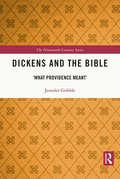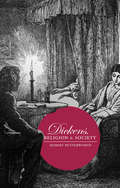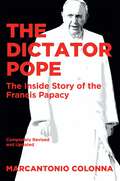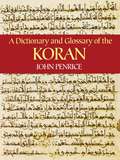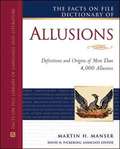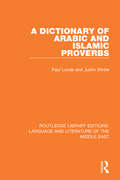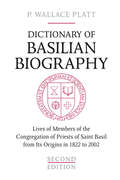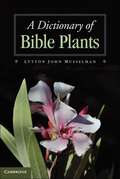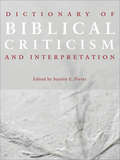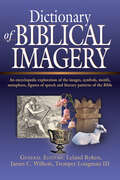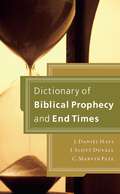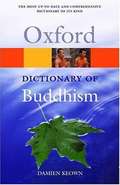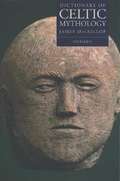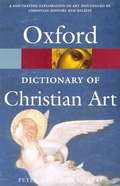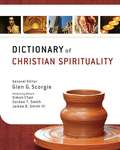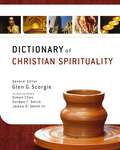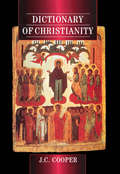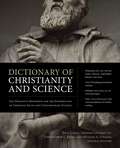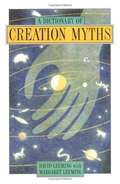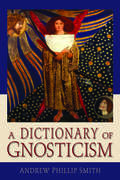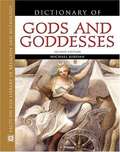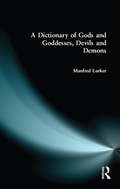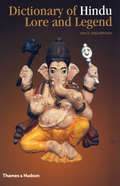- Table View
- List View
Dickens and the Bible: 'What Providence Meant' (ISSN)
by Jennifer GribbleAt a time when biblical authority was under challenge from the Higher Criticism and evolutionary science, ‘what providence meant’ was the most keenly contested of questions. This book takes up the controversial subject of Dickens and religion, and offers a significant contribution to the interdisciplinary area of religion and literature. In a close study of major novels, it argues that networks of biblical allusion reveal the Judeo-Christian grand narrative as key to his development as a writer, and as the ontological ground on which he stands to appeal to ‘the conscience of a Christian people’. Engaging the biblical narrative in dialogue with other contemporary narratives that concern themselves with origins, destinations, and hermeneutic decipherments, the inimitable Dickens affirms the Bible’s still-active role in popular culture. The providential thinking of two twentieth-century theorists, Bakhtin and Ricoeur, sheds light on an exploration of Dickens’s narrative theology.
Dickens, Religion and Society
by Robert ButterworthDickens, Religion and Society examines the centrality of Dickens's religious attitudes to the social criticism he is famous for, shedding new light in the process on such matters as the presentation of Fagin as a villainous Jew, the hostile portrayal of trade unions in Hard Times and Dickens's sentimentality.
The Dictator Pope: The Inside Story of the Francis Papacy
by Marcantonio ColonnaThe Inside Story of the Francis Papacy Could Pope Francis be the most tyrannical and unprincipled pontiff in modern times? Yes, says Church historian Marcantonio Colonna, in his controversial yet judicious new book, The Dictator Pope. Cardinal Jorge Bergoglio of Argentina was elected pope in 2013 as a liberal and a reformer. In fact, he was neither—except by coincidence. Though he was not well-known within the College of Cardinals that elected him, close observers in his native land already recognized him to be a manipulative politician, skilled at self-promotion, and a disciple of the populist dictator Juan Perón. Behind the mask of a genial man of the people is a pope who cares shockingly little about theology or the liturgy but is obsessed with his own power. Allying himself with the most corrupt elements in the Vatican, Francis rules by fear. He has obstructed or reversed the very reforms that were expected of him and attempted to alter Catholic teaching by subterfuge. In The Dictator Pope you will learn: Why the head of Francis’s own religious order thought he should not be made a bishop Why Francis may have diverted Church funds to support Hillary Clinton’s failed presidential campaign How true Church reformers have been punished by the Pope and his allies How Francis himself has mused that he might be the cause of a schism in the Church Why clerics in the Vatican have gone from dismissing Francis as a “clown” to fearing him as a dictator Marcantonio Colonna has exhaustively mined his extensive contacts in the Vatican to produce a provocative and revealing account of Pope Francis’s true motivations. The Dictator Pope is essential reading to understand one of the most enigmatic, and dangerous, figures to occupy the See of St. Peter.
A Dictionary and Glossary of the Koran
by John PenriceIt is every Muslim's duty to read the Koran and try to understand it, which can be a problematic task for those unacquainted with Arabic. The study and appreciation of Arabic literature likewise demands a thorough familiarity with the Koran; the majority of works by Muslim writers abound in allusions to its precepts and quotations from its pages. The sacred text's purity of style and elegance of diction make it the standard of Arabic.This classic guide to one of the world's most widely read books permits everyone, Muslim and non-Muslim alike, to understand the Koran -- even those with no prior knowledge of Arabic. Geared toward beginners, it was written to answer the need for an American version of the Koran in contemporary English. Each word is listed under its verbal root, grouping words without roots alphabetically, and numerous explanations of the text appear throughout to help beginners master some inevitable difficulties and to assist more advanced readers of Arabic in solving problems.
Dictionary of Allusions
by Martin H. ManserThis volume nearly doubles an earlier one limited to classical and biblical allusions, drawing as well from Shakespeare, Norse and other mythology, literary texts, historical events, and popular culture including film and television. In addition to explaining what people usually mean when they use the word or phrase and its origin or possible origins, the articles provide an example of its use, a guide for pronouncing any but common English words, and often cross-references to other articles. There is no bibliography. Annotation ©2009 Book News, Inc., Portland, OR (booknews.com)
A Dictionary of Arabic and Islamic Proverbs (Routledge Library Editions: Language And Literature Of The Middle East Ser.)
by Justin Wintle Paul LundeOne of the quickest ways to understand a people or a culture is to learn their proverbs. This anthology, first published in 1984, compiles in dictionary form proverbs from the Islamic world, particularly the Middle East and North Africa. The Arabs were the first to gather and annotate their own proverbs – the earliest collections date from the n
Dictionary of Basilian Biography
by P. Wallace PlattThe Dictionary of Basilian Biography contains 632 biographical entries on the members of the Congregation of Saint Basil who died in the years between 1822, when the congregation was founded, and 2002. The dictionary presents the personal background, education, and various appointments as well as the character, talents, and bibliography of each member, while defining the contribution of each in the educational or pastoral work of the Basilian Fathers. This heritage belongs not only to the Basilian Fathers or the Catholic Church, but to the wider societies and cultures of the countries that were touched by the work of the Basilians.This second edition of the Dictionary of Basilian Biography is approximately three times the size of the original edition by Father Robert J. Scollard, published in 1969. The increase in size is due not only to the additional number of members who died between that year and 2002, but also to additional archival research into the lives and careers of the early members of the Congregation in France. It represents eight years of work by editor P. Wallace Platt and his editorial board, enriching the book and balancing its presentation.
A Dictionary of Bible Plants
by Lytton John MusselmanThis book describes and illustrates each plant mentioned in both the Old and New Testaments and the Apocrypha. Drawing on Lytton John Musselman's extensive field investigations from Beirut to Borneo and from the Atlas to the Zagros mountains, it also includes his original images of each plant. Incorporating new research on their use, reviews are made of recent analytical studies of plants used in materials and technology as well as ancient grains, beer production, medicine, tensile materials, soap and other articles. Based on these materials, Musselman provides several new plant identifications for controversial biblical passages. In addition, the book surveys the history of Bible plant literature from the time of the Greeks and Romans to the present, and reviews and correlates it with Bible plant hermeneutics. Extensive references for further study are provided, along with an index to all verses containing references to these plants.
Dictionary of Biblical Criticism and Interpretation
by Stanley E. PorterFirst Published in 2007. Routledge is an imprint of Taylor & Francis, an informa company.
Dictionary of Biblical Imagery: An Encyclopaedic Exploration Of The Images, Symbols, Motifs, Metaphors, Figures Of Speech, Literary Patterns And Universal Images Of The Bible
by Tremper Longman III Leland Ryken James C. WilhoitChristianity TodayDictionary of Biblical ImageryThe Dictionary of Biblical Imagery
Dictionary of Biblical Prophecy and End Times
by J. Daniel Hays J. Scott Duvall C. Marvin PateThe Dictionary of Biblical Prophecy is a comprehensive reference tool designed to assist everyday people in understanding biblical prophecy. Based on solid scholarship, the dictionary contains clear and readable entries on a broad sweep of topics relevant to biblical prophecy, providing insight to complicated subjects in a balanced fashion.
A Dictionary of Buddhism
by Damien KeownA comprehensive dictionary of Buddhism is even now growing in the unconstrained dimensions of the Internet, notes Keown (historical and cultural studies, U. of London). By comparison, his effort is modest: a handy one-volume source for students and general readers seeking concise explanations of the various concepts, names, texts, and terms found in the Buddhist literature. The articles are highly cross-referenced. Appendices include maps, a pronunciation guide, a guide to Buddhist scriptures, and a chronology. Annotation (c)2003 Book News, Inc., Portland, OR (booknews.com)
A Dictionary of Celtic Mythology (Oxford Paperback Reference)
by James MackillopThe full richness of Celtic mythology--legends, sagas, folklore,traditions, places, and personalities--is concisely conveyed in this dictionary.
A Dictionary of Christian Art
by Peter Murray Linda MurrayThe Dictionary of Christian Art, now rebranded in the best-selling Oxford Paperback Reference series, is a unique and fascinating exploration of the art and architecture that has been influenced and inspired by biblical stories and Christian history and beliefs. The Dictionary combines general essays on the periods and styles important in the history of Christian art with lots of shorter entries that describe specific works, artists, themes, and visual images, and which give the reader practical guidance on where in Europe to locate the works described. The Dictionary of Christian Art is a unique and fascinating exploration of the art and architecture that has been influenced and inspired by biblical stories and Christian history and beliefs. Among the many features of this dictionary are: detailed essays on periods and styles in art and architecture, including Byzantine, Renaissance, Baroque; general background to the Old and New Testaments, and to Christian tradition and beliefs; forms of art influenced by Christianity, such as illuminated manuscripts, stained glass; artists and architects and their works, for example Fra Angelico, Donatello, Pugin, and many others; and places and buildings, including Assisi, Roma, St Paul's, the Sistine Chapel. There are also descriptions and explanations of features of Christian churches, significant saints, popes, saints, and rulers, and a glossary of Architectural Terms and detailed bibliography.
Dictionary of Christian Spirituality
by Glen G. ScorgieIn recent decades Christian spirituality, spiritual formation and spiritual theology have become important concepts in the global evangelical community. Consequently, an accessible and reliable academic resource is needed on these topics--one that will offer a discerning orientation to the wealth of ecumenical resources available while still highlighting the distinct heritage and affirming the core grace-centered values of classic evangelical spirituality. The Dictionary of Christian Spirituality reflects an overarching interpretive framework for evangelical spiritual formation as relational (connecting), transformational (becoming), and vocational (doing) dynamics. At the same time, contributors respectfully acknowledge the differences between Reformed, Holiness, and Pentecostal paradigms of the spiritual life. And, by bringing together writers from around the world who share a common orthodoxy, this reference work is truly global and international in both its topical scope and contributors. Entries give appropriate attention to concepts, concerns, and formative figures in the evangelical tradition of spirituality that other reference work neglect. They offer a discerning orientation to the wealth of ecumenical resources available, exploring the similarities and differences between Christianity and alternate spiritualities without lapsing into relativism. The Dictionary of Christian Spirituality is a resource that covers a wide range of topics relating to Christian spirituality and is biblically engaged, accessible, and relevant for all contemporary Christians.
Dictionary of Christian Spirituality
by Glen G. Scorgie Gordon T. Smith James D. Smith III Simon ChanIn recent decades Christian spirituality, spiritual formation and spiritual theology have become important concepts in the global evangelical community. Consequently, an accessible and reliable academic resource is needed on these topics—one that will offer a discerning orientation to the wealth of ecumenical resources available while still highlighting the distinct heritage and affirming the core grace-centered values of classic evangelical spirituality. The Dictionary of Christian Spirituality reflects an overarching interpretive framework for evangelical spiritual formation: a holistic and grace-filled spirituality that encompasses relational (connecting), transformational (becoming), and vocational (doing) dynamics. At the same time, contributors respectfully acknowledge the differences between Reformed, Holiness, and Pentecostal paradigms of the spiritual life. And, by bringing together writers from around the world who share a common orthodoxy, this reference work is truly global and international in both its topical scope and contributors. Entries give appropriate attention to concepts, concerns, and formative figures in the evangelical tradition of spirituality that other reference work neglect. They offer a discerning orientation to the wealth of ecumenical resources available, exploring the similarities and differences between Christianity and alternate spiritualities without lapsing into relativism. The Dictionary of Christian Spirituality is a resource that covers a wide range of topics relating to Christian spirituality and is biblically engaged, accessible, and relevant for all contemporary Christians.
Dictionary of Christianity
by J. C. CooperFirst Published in 1996. Routledge is an imprint of Taylor & Francis, an informa company.
Dictionary of Christianity and Science: The Definitive Reference for the Intersection of Christian Faith and Contemporary Science
by Christopher L. Reese Michael Strauss Paul Copan Tremper Longman IIIThe Dictionary of Christianity and Science provides, in one volume, entries on over 450 key terms, theories, individuals, movements, and debates at the intersection of Christian faith and contemporary science. In addition, because certain topics such as the age of the Earth and the historicity of Adam and Eve provoke disagreement among Christians, the dictionary includes “Counterpoints”-like essays that advocate for the views most commonly held among evangelicals. Representatives of leading perspectives present their arguments vigorously but respectfully in these advocacy essays, allowing readers to compare options and draw their own conclusions. The dictionary is also fully cross-referenced and entries include references and recommendation for further reading. Edited by Paul Copan, Tremper Longman III, Christopher L. Reese, and Michael G. Strauss, the Dictionary of Christianity and Science features a top-notch lineup of over 140 contributors in the fields of biblical studies, theology, philosophy, history, and various sciences. A unique reference work, it will be useful for scholars, pastors, students, and any Christian wanting to better understand the most relevant issues and ideas at the intersection of Christian faith and science.
Dictionary of Christianity in America
by Daniel G. Reid Robert D. Linder Bruce L. Shelley Harry S. StoutThis single volume does what most libraries cannot-- it places at your fingertips the whole spectrum of individuals, traditions, institutions, denominations, events, and ideas that have influenced North American religion and culture.
A Dictionary of Creation Myths
by David A. Leeming Margaret A. LeemingGod made Heaven, and then, after measuring the space underneath with a ball of thread, he began to form the earth. A mole asked to help, and God gave him the thread to hold while he wove the patterns of the earth. Sometimes the mole would let out too much thread, and finally the earth grew too large for the space under heaven. The mole was so upset that he hid under the earth. God sent the bee to look for him; he wanted the mole's advice on what to do about the mistake. The bee found the mole and he just laughed at the idea of advising God. The bee, however, hid in a flower and overheard the mole mumbling to himself about what he would do if he were God. 'I would squeeze the earth,' he said. 'That would make mountains and valleys and make it smaller at the same time.' When the bee heard this, he went directly to God and told him. God did what the mole had said, and everything fit fine." The myth of Rumanian Creation in which God weaves the earth from a ball of thread is just one the many stories that make up the wondrous world of creation myths. In virtually every culture throughout the ages, creation myths have played a vital role in providing not only explanations of the origins of societies but also specific cultural identities--serving as a "projection of an aspect of a culture's soul." Covering thousands of years of intricate creation tales, A Dictionary of Creation Myths is the first and most comprehensive work devoted to creation myths from cultures throughout the world. With an easy-to-use A-Z format, this around-the-world tour provides access to information on the beliefs(both exotic and ordinary) of ancient civilizations from Sumeria and Babylonia to Egypt, Greece, and ancient Rome, from India and China to Japan and Indonesia, as well as the rich mythological history of Native Americans, the indigenous peoples of Australia, and many other cultures. We read of the creation myth of the Diegueno tribe of southern California in which the creator, Tu-chai-pai, made the earth female and the sky male and then formed mud into people; and the myth of Japanese creation in which Izanagei, and his sister Izanami, watch the first land form from ocean water dripping from Izanagi's spear. Alongside these ancient beliefs are the more modern, such as Darwin's theory of evolution and the big bang theory. Each entry identifies the culture associated with the myth, and each myth is retold in clear, eloquent prose, with extensive cross-referencing to guide readers to other entries. Throughout, the authors share insightful analyses of the surprisingly intricate relationship of certain myths across cultures, regions, and time. From cosmic eggs and the Garden of Eden to the Spider Woman and the Gaia Principle, from myths of the apocalypse and the great world religions to myths of love, rebirth, and science, this guide illuminates the phenomenon of creation from all aspects of the human experience. Richly illustrated,A Dictionary of Creation Myths is essential for anyone who has ever wondered how the world was created, where we came from, or why we are here at all.
A Dictionary of Gnosticism
by Andrew Phillip SmithA Dictionary of Gnosticism is a scholarly yet accessible guide that covers the people, mythology, movements, scripture, and technical terms related to this pre-Christian Western religion. It contains nearly 1700 entries, from Aachiaram, an angel in the 'Secret Book of John to Zostrianos', a third-century Gnostic text, and is a reliable reference for the Nag Hammadi library and other Gnostic texts. An introduction explains who the Gnostics were and provides a whirlwind tour through the history of this captivating movement.
A Dictionary of Gnosticism
by Andrew Phillip SmithA Dictionary of Gnosticism is a scholarly yet accessible guide that covers the people, mythology, movements, scripture, and technical terms related to this pre-Christian Western religion. It contains nearly 1700 entries, from Aachiaram, an angel in the Secret Book of John to Zostrianos, a third-century Gnostic text, and is a reliable reference for the Nag Hammadi library and other Gnostic texts. An introduction explains who the Gnostics were and provides a whirlwind tour through the history of this captivating movement.
Dictionary of Gods and Goddesses
by Michael JordanA television journalist and specialist on the anthropology of religions, Jordan addressed his 1993 first edition to students and travelers, describing deities likely to be encountered in studying western civilization and visiting common Asian tourist sites. Here he accounts for a broadening of interest in cultures of the southern hemisphere and some of the less mainstream aspects of European history. For well known deities of past times, he includes such information as origin, known period of worship, centers of cult, art references, and literary sources. Cross-references are abundant, and he includes peripheral mentions (indented) in the index.
A Dictionary of Gods and Goddesses, Devils and Demons (Routledge Dictionaries Ser.)
by Manfred LurkerContaining around 1,800 entries this Dictionary covers, in one volume, all the important deities and demons from around the world. The gods of ancient mythology appear alongside the gods of contemporary religion, and `lesser' mythologies and religions are also fully covered. The author provides an extensive network of cross-references, allowing the reader to draw cross-cultural comparisons. The Dictionary will be an invaluable source of information for anyone interested in comparative religion or the diversity of religious views throughout the world.
Dictionary of Hindu Lore and Legend
by Anna L. DallapiccolaProvides over 1,000 accessible, informative and authoritative entries that answer any major question about Hinduism, it's mythology, practices, customs and laws India is so vast that each of its regions is a land in its own right, with diverse languages, customs, and cultural traditions. Yet shared social systems, firmly grounded in religious beliefs, provide the cohesive force that unites over a billion people of different backgrounds. Hinduism is the main religion of India, and this new dictionary provides an unrivaled insight to all aspects of Hindu life, past and present. Some thousand illustrated entries elucidate the history of Hinduism, its mythology, art, architecture, religion, laws, and folklore. The development of Hinduism is presented from its ancient manifestations in local cults and epic poems to modern-day festivals and customs worldwide. The complex relationship between the multitude of gods, goddesses, and semi-divine beings is brought to light in the articles on religion and mythology, while its rich imagery is revealed in the entries on architecture, sculpture, painting, dance, and theater, including works of art illustrated here for the first time. Food and etiquette, the caste system, Ayurvedic medicine, love and marriage, and contemporary practices are just a few of the topics explored. Maps and entries on the major cities and places of pilgrimage in India, as well as a concise chronology and a list of principal dynasties, provide a clear overview of the geography, history, languages, and vibrant religious and cultural traditions of Hinduism. This volume will serve as a lively and indispensable guide for those preparing a visit to India, for Indians living in the West, for students, or for anyone interested in the subcontinent. 275 b/w illustrations.
